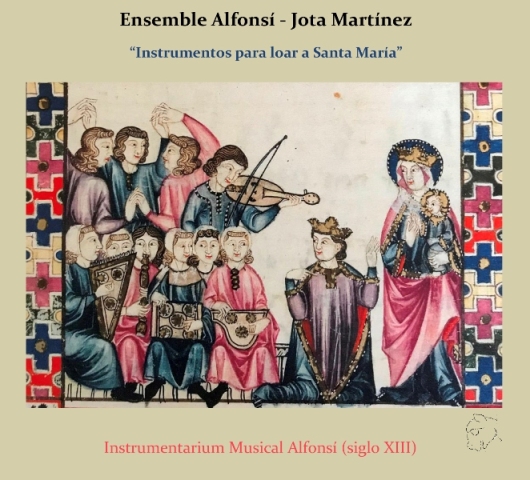Bienvenido a mi web personal

Ensemble Alfonsí - Jota Martínez. "Instrumentos para loar a Santa María".

En 2017, creé el Ensemble Alfonsí para ofrecer algo que presentamos como una “experiencia alfonsí” sin precedentes. Música de los manuscritos alfonsíes, con los instrumentos representados en los mismos, algo inédito y novedoso hasta el momento. Claro que ya se han hecho muchos conciertos sobre las Cantigas de Santa María, pero hasta ese momento, nadie lo había hecho con los instrumentos musicales de su misma época y que quedaron atrapados en el tiempo, como en una fotografía, en las miniaturas e iluminaciones de los mismos manuscritos.
Además de las fuentes iconográficas que nos han llegado y las escasas entradas literarias y registros de la época, otra fuente muy importante a la hora de reconstruir, tanto los instrumentos como el repertorio, es el folclore y la música tradicional y de raíz. En la cultura popular de todo el Mediterráneo han quedado pistas para toda esta recuperación, y como organólogo, musicólogo y medievalista, que también me alimento y enriquezco de estas tradiciones, he querido encontrar las conexiones que nos unen a este pasado para mostrar, sin ninguna duda y con total confianza y realismo, una propuesta nueva sobre este repertorio mariano del siglo XIII, uniendo el rigor histórico a la tradición, para poner en valor este legado de nuestro patrimonio inmaterial, tan castigado en algunas ocasiones. Para ello, me he rodeado de un ensemble en el que sus integrantes no solo han tenido la formación académica necesaria para tocar los instrumentos tan especiales que tocan, sino que además han estado en contacto permanente con las músicas tradicionales peninsulares y del Mediterráneo, así como con músicas contemporáneas a nosotros, que han exigido de ellos una preparación para la improvisación y una apertura de mentes a la mistura y el entendimiento musical entre culturas.

Algunos de los manuscritos alfonsíes, perfectamente iluminados y miniados, son una referencia iconográfica de primer orden para conocer las costumbres y forma de vida de su época. Como no podía ser de otro modo y dada su gran pasión por la música, también quedaron representados muchos instrumentos musicales puestos en manos de sus tañedores. Esta información visual, para los que nos dedicamos a los instrumentos medievales, es fundamental y nos da mucha información sobre los instrumentos y la música del siglo XIII.
A partir de este momento a todos los instrumentos musicales y artilugios sonoros representados en los manuscritos alfonsíes, los llamaremos, “instrumentos alfonsíes” y la colección de todos los instrumentos, recibirá el nombre de “Instrumentarium musical alfonsí”. No quiere decir esto que fueran instrumentos que el rey tocara o que solo se tocaran en su corte o que fueran inventados, descubiertos o recopilados por él o sus súbditos en sus viajes, no, nada de esto. Está claro que son solo representaciones de instrumentos que se conocían en la época. Algunos de ellos, de la tradición clásica, algunos totalmente de moda y otros, posiblemente, desarrollándose y en experimentación en ese preciso momento, como se expondrá en el estudio organológico que estoy preparando y que publicaré en breve. Pero me parece práctico y acertado usar un nombre que los aúne a todos, y considero que este es apropiado.
About the project
In 2017, I created the Alphonsian Ensemble to offer something we presented
as an unprecedented “Alphonsian experience”. Music of the Alphonsian
manuscripts, with the instruments represented in them, something unpublished
and novel so far. Of course, many concerts on the Cantigas de Santa María
have already been done, but until that moment, nobody had done so with the
musical instruments of their own time and that they were caught in time, as
in a photograph, in the miniatures and illuminations of the same manuscripts.
In addition to the iconographic sources that have reached us and the few
literary entries and records of the time, another very important source when
it comes to reconstructing both the instruments and the repertoire is
folklore and traditional and root music. In the popular culture of the
entire Mediterranean, there have been clues for all this recovery, and as an
organologist, musicologist and medievalist, enriched by these traditions, I
wanted to find the connections that bind us to this past to show, without
any doubt and with total confidence and realism, a new proposal on this
Marian repertoire of the thirteenth century, linking historical rigor to
tradition, to value this legacy of our intangible heritage, which has been
badly treated on some occasions. For this task I have surrounded myself with
an ensemble whose members have not only had the necessary academic training
to play the special instruments they play, but they have also been in
permanent contact with traditional peninsular and Mediterranean music, as
well as with contemporary music to us, which has demanded from them a
preparation for improvisation and an open mind to mixing and musical
understanding between cultures.
Jota Martínez
From this moment on all musical instruments and sound contraptions
represented in the Alphonsian manuscripts, we will call them "Alphonsian
instruments", and the collection of all instruments will be called "Alphonsian
Musical Instrumentarium". This does not mean that they were instruments that
the king played or that they only played in his court or were invented,
discovered or collected by him or his subjects in his travels, no, none of
this. It is clear that they are only representations of instruments that
were known at the time. Some of them, of the classical tradition, some
totally fashionable and others, possibly, being developed and experimented
at that precise moment, as it will be showed in the organological study that
I am preparing and that I will be publishing shortly. But it seems practical
and correct to use a name that brings them all together, and I consider this
to be appropriate.